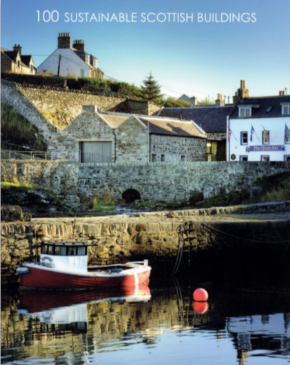100 Sustainable Scottish Buildings
100 Sustainable Scottish Buildings, Richard Atkins and Emily Stephen (editors), SEDA, 2017, 240 pages, colour illustrations.
100 Sustainable Scottish Buildings is not a list of the ‘top 100’ sustainable buildings in Scotland; it is much more than that. An instructive assemblage of different types over different periods, it demonstrates the diversity and potential of a thoughtful response to social, economic, environmental sustainability. It is superbly illustrated. Punctuated by five short strategic pieces on central themes such as circular economy, social capital and buildings as agents of change, this is a useful inspiration and reference aimed at all those who work in the built and historic environment, demonstrating fulsomely what it claims, namely that ‘sustainability is a responsibility and an opportunity, not a hair shirt to be endured’.
The impressive international credentials of the contributors give an accurate steer as to the calibre of the monograph: Robin Harper, the first Green MP in the UK, provides a motivating foreword, followed by Professor Ray Cole of University of British Columbia, Canada, Professor Sandy Halliday of Gaia Research, and Chris Butters, guest professor at the Oslo School of Architecture and St John’s University Minnesota. David Cheshire of Aecom and Chris Stewart of Collective Architecture and SEDA further enrich the quality, while the co-editor and contributor, Richard Atkins, is co-author of the RIBA’s Sustainability Guide to the Plan of Works (2013, 2016).
There is much to savour on what is possible from the contents. Refurbishments are detailed constructively: notably, the Nicolson Street Housing, Edinburgh, by Gaia Architects, a city-centre, Category-B-listed building, where work informed by research ensured that all toxic materials and potential asthma and allergy triggers were removed, while materials with hygroscopic properties and breathing walls aided moisture management. Similarly, the ‘whole-house’ sustainable refurbishment undertaken at Scotstarvit Cottage by Historic Environment Scotland and the National Trust for Scotland used hemp and breathable perlite insulation, retaining all original features and passive ventilation. Challenges, such as the re-fitting of the Category-A-listed Royal Commonwealth Pool by S&P Architects, show what can be achieved successfully within an existing envelope, using filtration systems, solar heating and recycled water.
Historical types are explored for their early wisdom: for example, the colony housing in Edinburgh’s Stockbridge with a layout that combines the importance of sunlight with the advantages of communal living, low-rise accessibility, and simple practicality and compactness.
New designs enthuse those handling work in historic settings. Gokay Deveci’s affordable, low-energy housing at Tigh-na-Claddach on Dunoon’s seafront proves that ‘sustainable energy-efficient design is possible on a social housing budget’. Under the theme of work, Gaia Architects’ Straw Bale Office, Dunning, is a useful example of imaginative experiment using local and reclaimed materials sourced within 20 miles, from hazel twigs to wool insulation.
In conclusion, this book delivers, as Professor Fionn Stevenson of Sheffield School of Architecture advises: ‘If you want to truly understand the green spirit of ecological building design that is alive and thriving in Scotland... there is no better collection in the UK to guide students and practitioners alike’.
This article originally appeared as ‘Not a hair shirt’ in IHBC’s Context 154, published in May 2018. It was written by Deborah Mays, head of listing advice at Historic England and a former HESPR registered consultant.
--Institute of Historic Building Conservation
Related articles on Designing Buildings Wiki
IHBC NewsBlog
Images from inside a Grade II listed hotel show the scale of its collapse
The Corbett Arms in Tywyn has fallen into serious disrepair.
Old Sarum fire in listed (& disputed) WW1 Hangar - Wiltshire Council has sought legal advice after fire engulfed a listed First World War hangar that was embroiled in a lengthy planning dispute.
UK Antarctic Heritage Trust launches ‘Virtual Visit’ website area
The Trust calls on people to 'Immerse yourself in our heritage – Making Antarctica Accessible'
Southend Council pledge to force Kursaal owners to maintain building
The Council has pledged to use ‘every tool in the toolbox’ if urgent repairs are not carried out.
HE’s Research Magazine publishes a major study of the heritage of England’s suburbs
The article traces the long evolution of an internal programme to research 200 years of suburban growth
IHBC Context 183 Wellbeing and Heritage published
The issue explores issues at the intersection of heritage and wellbeing.
SAVE celebrates 50 years of campaigning 1975-2025
SAVE Britain’s Heritage has announced events across the country to celebrate bringing new life to remarkable buildings.
IHBC Annual School 2025 - Shrewsbury 12-14 June
Themed Heritage in Context – Value: Plan: Change, join in-person or online.
200th Anniversary Celebration of the Modern Railway Planned
The Stockton & Darlington Railway opened on September 27, 1825.
Competence Framework Launched for Sustainability in the Built Environment
The Construction Industry Council (CIC) and the Edge have jointly published the framework.















